As the naval treaties lapsed in the late 30s, a new type of ship became possible, something more powerful than the treaty cruisers but smaller than a full-size battleship. Several nations looked into building this kind of ship, but only the US actually built them, in the form of the Alaska class large cruisers. The process of actually reaching a consensus in favor of the ships was tortuous, and things got even worse when it was time to actually design them.

Alaska on her shakedown cruise
The first batch of design studies were an interesting hybrid of cruiser and battleship practice. Unlike contemporary cruisers, they were given a proper TDS, although one designed against a 500 lb charge instead of the 700 lbs of the Iowas. The inner edge of the immune zone was set at a much shorter range than was common for battleships, as a ship operating independently might well have short-range encounters that a battleship's screen would intercept. Three of the four were to be protected against the extremely powerful 12" gun, which in turn pushed up size and led designers to use more elements of battleship practice. This formed a vicious cycle, and the largest design from the initial phase, armed with 12 12" guns, had a standard displacement of 38,700 tons, larger than the North Carolina and South Dakota classes. Another, with 9 guns and a bigger immune zone, actually had a thicker belt than the Iowas. All of these designs were rightly seen as too big, with two Iowas costing as much as three of the smallest design armored against the 12" gun.
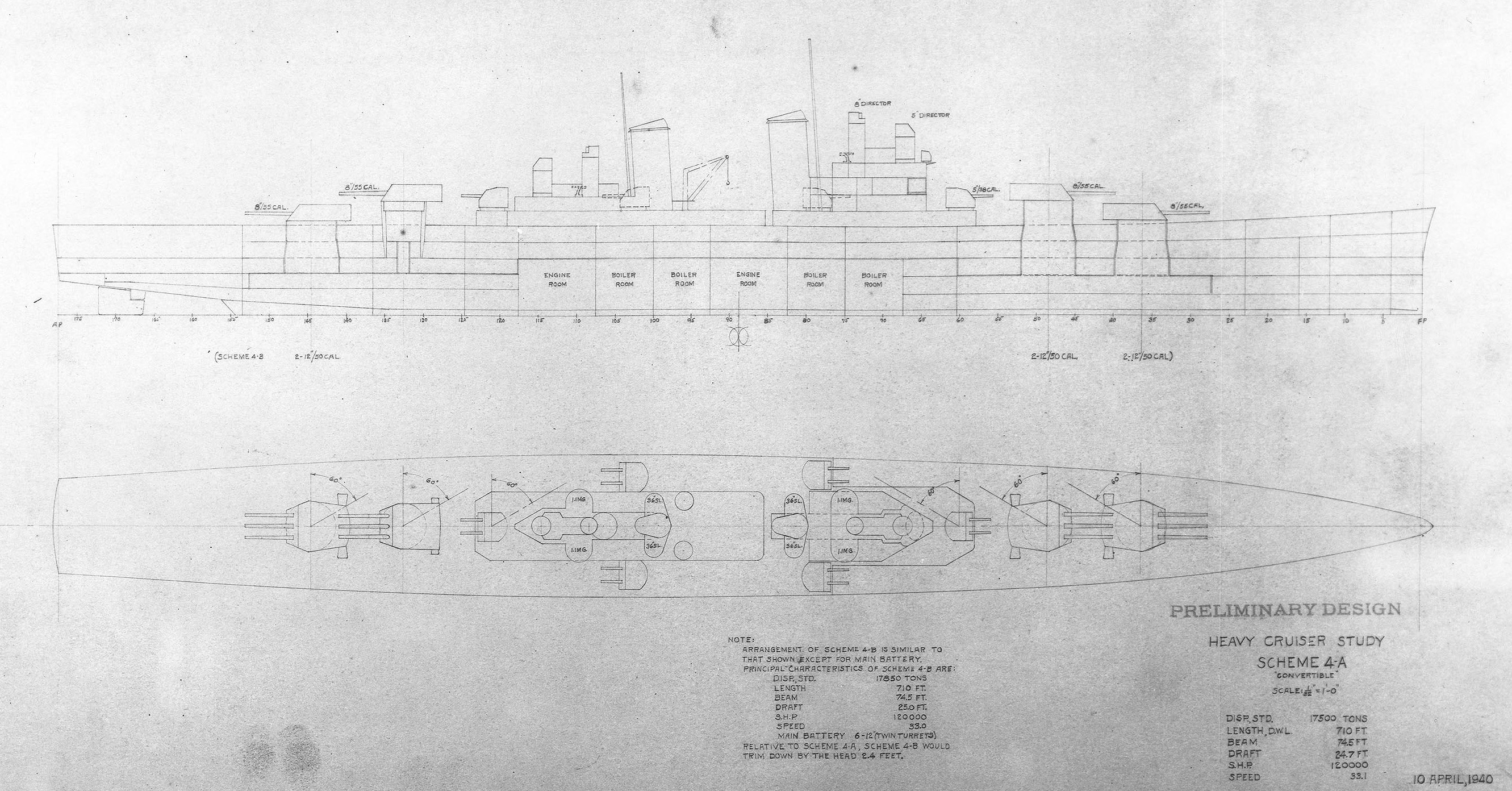
The design for the "convertible cruiser"
The designers were sent back to the drawing boards to try again, including a rather odd request to study a ship that could be armed with either 12 8" or 6 12" guns interchangeably. Three of the four barbettes were designed to take either a triple 8" or a twin 12", while the fourth would be left empty if the 12" gun was selected. The motivations behind this plan are not entirely clear, but it seems that the General Board was worried about foreign cruiser-killers making an unexpected appearance. They could either switch the ships over quite late in design, or replace the guns after they entered service, giving a quick response if they found foreign ships outmatching their 8" cruisers. In any event, this plan was discarded, and after much wrangling between those in favor of a slightly bigger 8" cruiser and the faction who wanted a balanced 12" ship, a compromise design was settled on. The side protection over the magazines was based on a notional 10" gun, considered equivalent to the 11" German gun that was the largest expected aboard a commerce raider, while the machinery would get 8" protection. The immune zone, starting at 15,000 yards, would be based on the 60° angle of impact used for cruisers instead of the 90° angle used for battleships, thinning the required belt significantly.1 The ship was not expected to fight at long range, so deck protection, a 2" bomb deck and 4" main armored deck, was set by concerns about bombing instead of gun range. A proper TDS was impossible given the size of the ship, and a simple triple bottom was incorporated into the design instead.
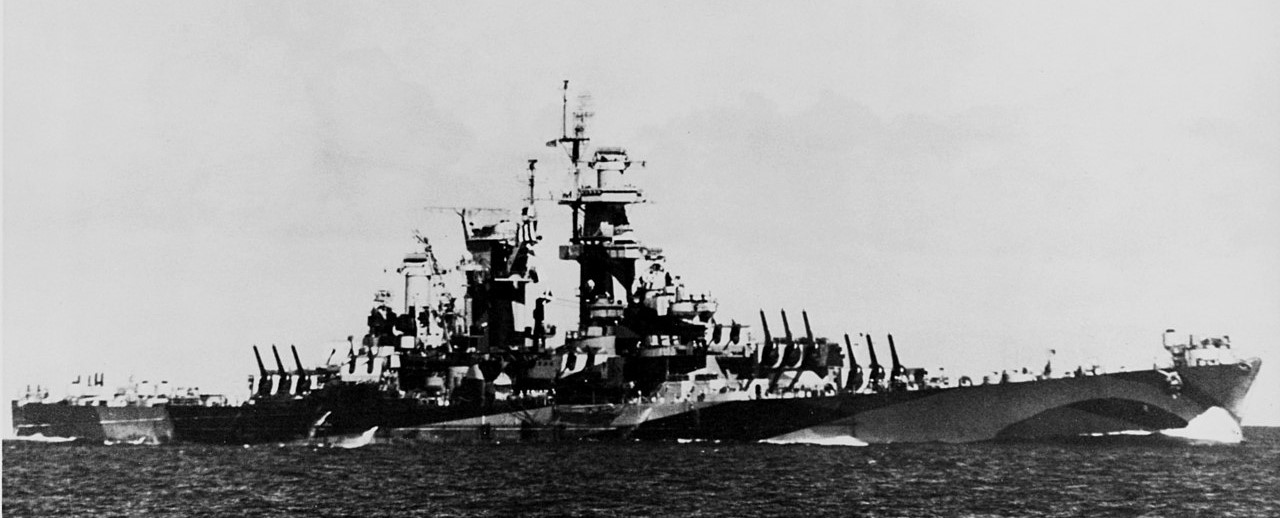
Guam
This design, with 8 12" guns (two triples and a superfiring twin) came in well above the 24,000 ton target, and even going to three twins and cutting deck armor 25% couldn't bring it back down to that figure. This was seen as an unacceptable amount of firepower, particularly aft, and more studies resulted. Some looked at a triple aft and two twins forward, while others investigated if it would be possible to fit a TDS, although the loss of speed involved was considered unacceptable given the ship's role as a cruiser, likely to undertake independent operations. Admiral Stark, the CNO, also requested studies, including some with as few as four guns, in an attempt to drive size down. But some consensus was finally forming in July 1940, after at least 16 sketch designs and 6 months of confusion in high echelons of the Navy. The final decision was for a variant of the earlier compromise design, with 8 12" guns and a speed of 33 kts using the same machinery as the Essex class carriers. The belt was made uniform, as bulkheads to stop the magazines being penetrated by oblique machinery hits soaked up most of the savings from thinner belts, and a battleship-type fire-control tower was finally fitted to take advantage of the 12" gun's range, although they had a cruiser secondary battery of 12 5" guns and two Mk 37 directors.
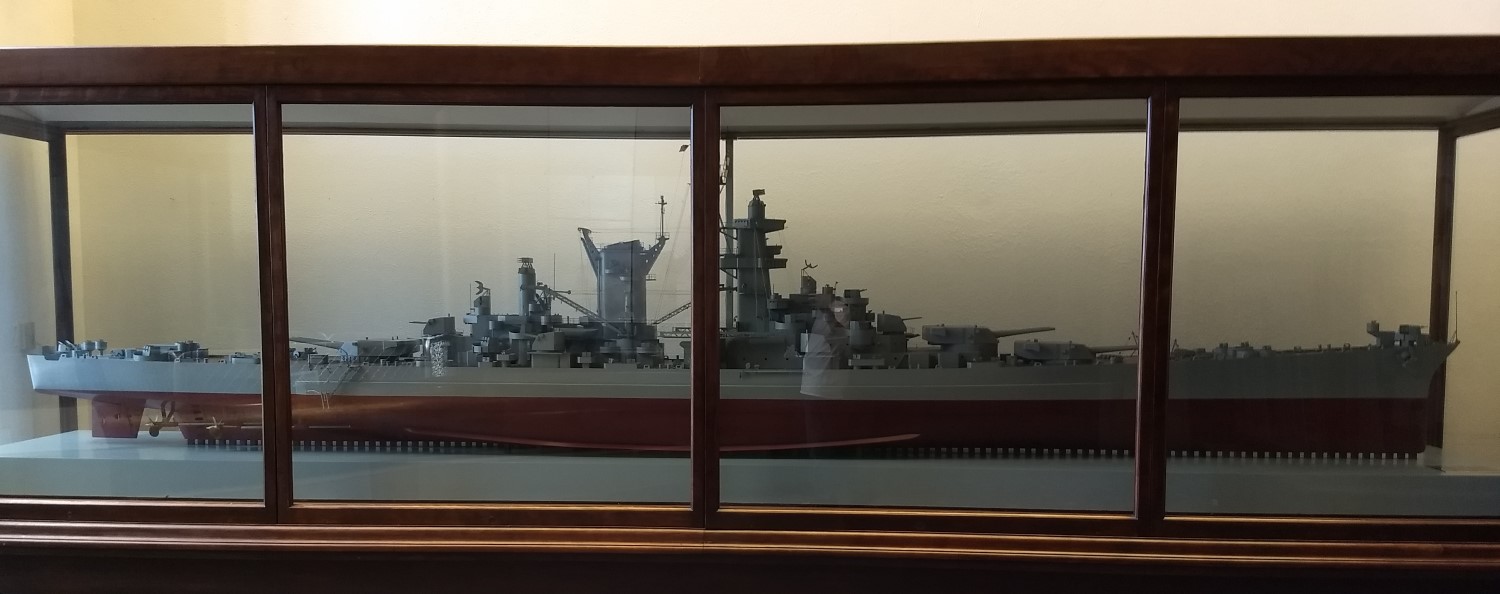
The gorgeous model of Alaska on display at the Science Museum of Oklahoma.2 Note the cruiser-style single rudder, which gave these ships relatively poor maneuverability.
This decision was timely, as the fall of France to the Germans in June had opened the way for a major expansion of the USN. Previously, it had been assumed that the British would deal with the Germans, leaving the USN to worry only about Japan. Now, there was a real chance that Britain would fall, leaving the Germans in control of the combined fleets of Europe. Thus, on July 19th, America passed the Two-Ocean Navy Act, which authorized six of the new large cruisers. Detailed design began, and by the following May, enough weight was left over to replace the superfiring twin with a triple.
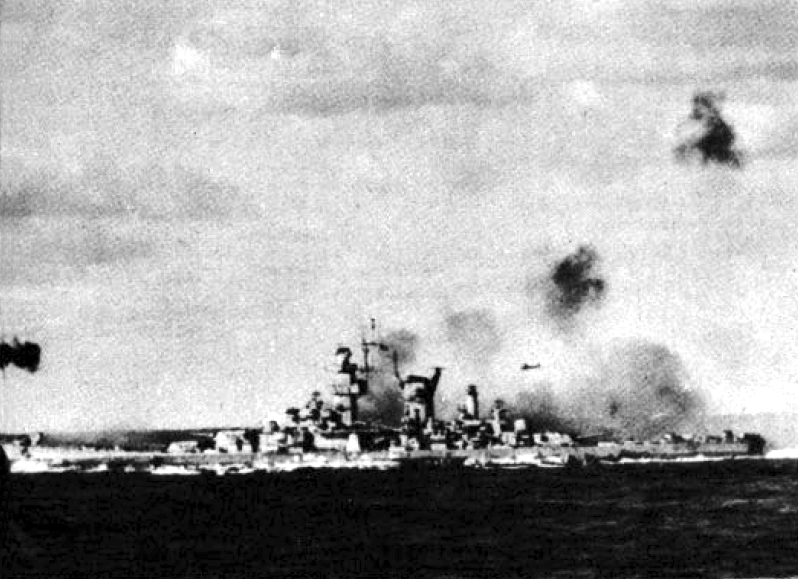
Alaska under air attack
The new cruisers were named after territories of the United States in recognition of their intermediate nature.3 Alaska was laid down ten days after the attack on Pearl Harbor at New York Shipbuilding Corporation,4 with Guam following on February 2nd, 1942. They commissioned in June and September 1944, respectively. They gave good service in the closing months of the Pacific War in the same roles as the fast battleships, but both decommissioned in February 1947 after less than three years of service. They remained in reserve until 1961, when they were broken up, a sad fate for such interesting ships. An argument could be made that they would have been a better choice than the Iowas for preservation, thanks to their smaller size and lower running cost, but this was probably ruled out by the fact that only two ships were available.
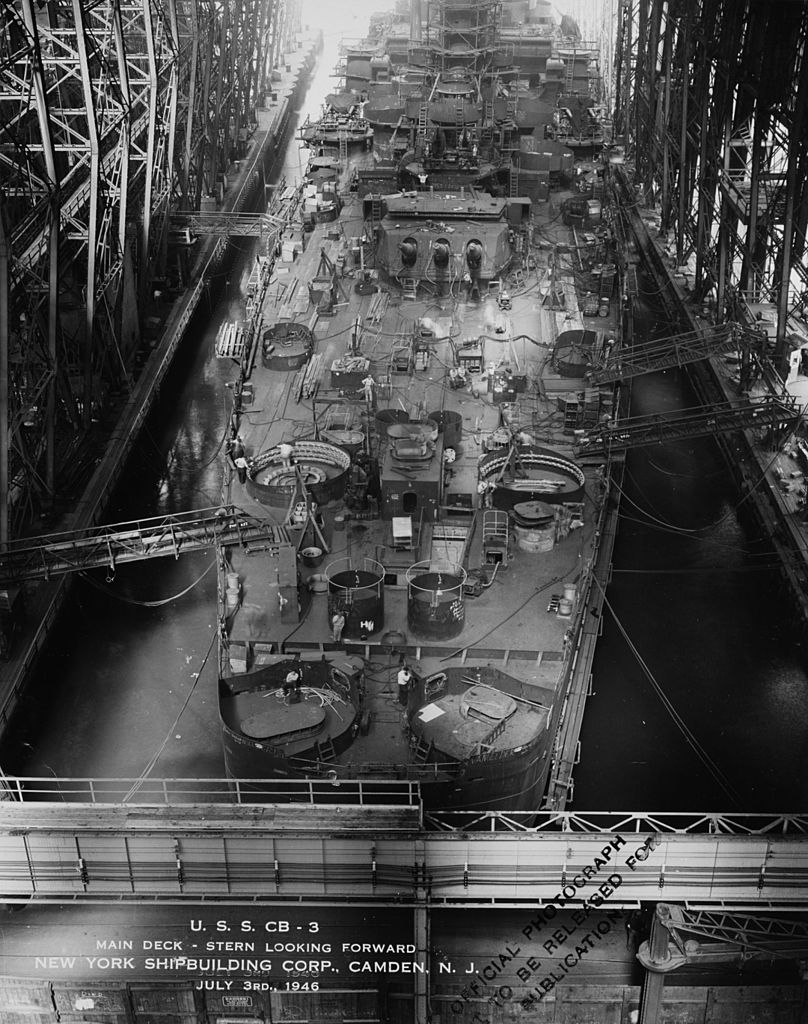
Hawaii in July 1946
The other four vessels were suspended along with the Montanas in April 1942, although Hawaii was put back in the plan in mid-1943 and laid down that November. The other three were cancelled that June, and Hawaii was launched two months after the end of the war. She was retained as at this point the US had only six ships capable of providing big-gun support to the carriers. Within a few years, there was obviously no need for her to be completed in her original configuration, although the existence of such a large hull had obvious appeal for conversion to other roles. Serious proposals were made for completing her as a guided-missile cruiser, which died when it was pointed out that electronic limitations would make her only slightly more effective than a converted heavy cruiser of half her size. The next plan was to make her a command ship, but this was also not pursued due to the same capability being available at lower cost. Plans continued as late as 1957, when a proposal called for her to carry 20 Polaris ballistic missiles, along with Talos and Tartar SAMs. But eventually it became obvious that the hull was a white elephant, and it was scrapped in 1959.
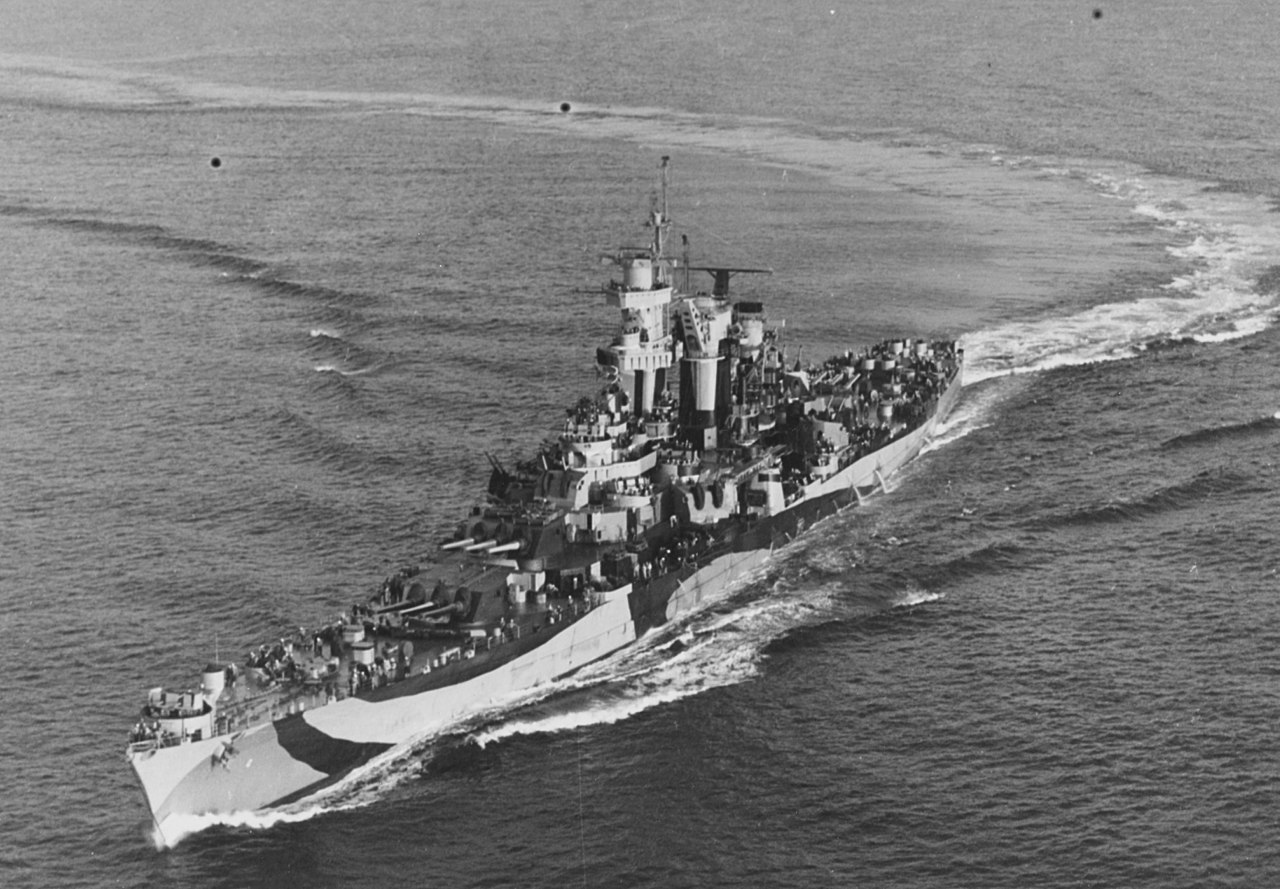
Guam at sea, 1944
Now that we've looked at the history of the Alaskas, it's time to return to the nomenclature question. Were they battlecruisers, as alleged by a number of their critics? In some ways, they do closely resemble Fisher's first battlecruisers. Both were built essentially as cruiser-killers with a major eye on commerce protection. But there are several key differences. Fisher's ships were the same size as contemporary battleships and carried the same guns, with a secondary mission to stand in the line of battle. None of this applies to the Alaskas, which were very clearly the products of American cruiser doctrine. They were never intended to fight capital ships, and were considerably smaller than contemporary battleships. The only post-WWI battleships of comparable size are the Dunkerques, built almost a decade earlier. The Alaskas are properly of a generation after the Iowas, and as such should be considered alongside the Montanas, which were twice their tonnage. Comparisons to the later battlecruisers fail even more clearly. Many of them were essentially fast battleships, a type exemplified in WWII by the Iowas. A few of the wartime battlecruisers departed from this mold, but the Alaskas are not particularly close to either Fisher's "Large Light Cruisers", designed apparently to fight pre-dreadnoughts in the Baltic, or to the American Lexingtons, intended as extremely fast and heavily-armed scouts. They are instead the logical extension of the heavy cruiser, and deserve to be remembered as such, and as vessels that, while too late for their intended roles, gave good service in their short careers.5
1 The basic justification for this was that battleships were expected to fight broadside-to-broadside, while cruisers were more likely to engage in chases, where the target ship would be ahead of or behind the beam. ⇑
2 I have no clue why this model was included in Oklahoma's allocation of naval models, but it is unbelievably pretty. My photo. ⇑
3 The planned names were Alaska, Guam, Hawaii, Philippines, Puerto Rico and Samoa. Alaska and Hawaii didn't become states until 1959. ⇑
4 It's worth pointing out that NYSC wasn't involved with the battleship program, so these ships didn't trade off against more Iowas. ⇑
5 I have settled on "Cruiser Killers" as my preferred nomenclature for the broader type, because while the Alaskas are very much the product of US cruiser doctrine, the same is not true of other ships of the type, some of which were more clearly small, fast battleships. ⇑

Comments
(wasn't sure if you wanted this discussion here or the other thread, feel free to delete)
I will fight you to the ends of the earth on this one bean, they’re battlecruisers.
The purpose of the Alaskas was to run down and utterly dominate enemy cruisers. And, as Ian Argent points out, they’re not that far off from the Kongos in size and capability. That’s the classic BC mission, and they’re sized to do that appropriately, being substantially larger and more powerful than any existing cruiser. That’s not as big as an iowa or montana because the gap between BBs and cruisers had grown considerably in the decades since invincible. The UK’s last armored cruisers were 14kt tons, compared to 20kt for Dreadnought. to beat up armored cruisers you had to be BB sized. But by 1940, big cruisers are 15-17kt, but BBs are 55kt. Building something BB sized to beat up on them would be pointless. Besides, what what would a 1940 BB sized battle cruiser even look like?
They were also a colossal waste of money, and demonstration of the extreme wealth advantage that the allies held over the axis, that they could afford custom extravagances like a bespoke 12 inch gun and still massively outproduce the axis in every area that mattered.
Names and roles aren't static over time, and we have to look at the Alaskas in role and design history at their time. The first generation of BCs may have been intended to beat up on ACRs, but the ACRs were practically capital ships already, and they went away because the BCs replaced them in the "fast capital ship" role. Remember that the Invincibles were authorized as "Dreadnought Armored Cruisers". By the end of WWII, the two types had merged to the point where HMS Hood, a "battlecruiser", was the largest warship in the world for most of the interwar years. The treaty heavy cruisers ultimately descended from the Hawkins class, which were big light cruisers, and not from the ACRs. The Alaska was a bigger version of that, filling a gap that had grown up because of the treaty.
The Kongos were very old, dating back to before WWI. This is what happens with a couple decades of ship development under your belts.
There's two within a three-hour drive of you. Go take a look.
Ok, a ballistic missile cruiser just sounds awesome, so they should have done it anyway.
Guessing, but was this because the early ships were limited by the single pair of illuminators, fore and aft?
Hey, don't drag me into this : ) - or at least not on the side of calling the Alaskas anything with "battle" in their name, just because they're around the size of the Kongos.
The design choices (as written up by Bean) including the armament and armoring schemes, are not Line-of-Battle choices. They are Enlarged Cruisers, not Pocket Battleships.
Opinions follow: Cruisers "cruise" - they go out and about. Battleships go out looking for fights; the BB's reason for being is to find the other side's fleet and destroy it, while the cruiser's reason for being is to defend one's own vessels (both fleet and merchant) and to prey on the enemy's escorts and merchant marine.
Pretty much. You can't mount those too close together without a lot of work, and the system really wasn't set up to support more than 2 per end, and no matter how big the ship is, it still only has two of those.
1957 is when the Italians started the rebuild of their 11,000 ton light cruiser Giuseppe Garibaldi, with four ballistic missile tubes (as well as a twin-arm Terrier launcher) replacing the aft 152mm turrets and I think the catapults.
The tubes were originally designed for Polaris missiles- these were never delivered, and Italy's indigenous Alfa ballistic missile was never launched from a ship.
Cassandra,
Not sure if you’ll see this but I would fight to the ends 9f the earth that these are large cruisers not battlecruisers.
Let’s go back and look at what defined a battlecruiser when the type was first created.
Current battleship size guns and size A reduction of gun numbers and armor in exchange for speed. In all other respects built to battleship standards (TDS as applicable etc)
The one real exception to this is Hood which doesn’t make many of these tradeoffs because she is much larger than contemporary battleships. And most people agree that she blurs the line between battlecruiser and fast battleship.
Now consider the Alaskas, 12” guns when all US BBs had 16” Significantly smaller than contemporary US BBs Designed to US cruiser standards not BB standards so no TDS etc. Also the design very very clearly isn’t a BB that has traded armor and firepower for speed. They are also not any faster at 33 knots than the Iowas. (Which are also not battlecruisers.. just saying).
To my way of thinking when you consider all that it’s pretty clear that these are in fact just what the USN said they were. Large cruisers not battlecruisers.
Germany's battlecruisers had smaller guns that their battleships yet I don't see [m]any people deny that they were battlecruisers.
Germany's Von der Tann, Moltke, and Seydlitz class battlecruisers had the same 28 cm SK L/50 guns as the contemporary Nassau class dreadnought battleships. By the time the US built the Alaskas, it hadn't built a 12"-gun battleship in 30 years, and the Alaskas used a new design gun optimized for their needs.
There's never been a requirement that a battlecruiser's guns be equal to the largest battleship guns in their navy, but it's I think strongly implied that they need to have some sort of contemporary battleship gun.
Yeah. The only battleships to have guns within an inch of Alaska after 1930 were the Scharnhorsts, and they were (a) a decade earlier and (b) built weirdly because the Germans were trying to butter up the British. The fact that they were planned to get 15" guns says quite a bit about how the Germans thought about them. Context is really important in this, and the proper context for the Alaskas is Montana, which they look nothing like.
I actually disagree with this. If you look at all of the ships that are universally agreed to be battlecruisers, they're pretty much "battleship-grade guns, battleship size, significantly faster than normal battleships". Besides the classic BCs, that most clearly captures Iowa. (Nagato is the only really borderline entry in this category.) I'm not going to start a campaign to call them battlecruisers in general use, but I think it's true as a matter of classification.
Oh $DEITY, we're doing this again?
In WW2 ships with 12" guns are battleship grade. Scharnhorsts, Bretagnes, Ganguts, and USS Arkansas. How many cruisers serving in WW2 (or after) have guns over 10"?
The Alaskas have a heavier main gun broadside than HMS Dreadnought and half the battlecruisers ever built. How many cruisers serving in WW2 are there that can say the same?
@bean, the most common informal definition of battlecruiers I've seen/heard is "big, fast, heavily armed, not so great on the armour". Even the WW1 BCs are not as well protected as their BBs overall (source: Drachinifel). Iowas have battleship armour, so fast battleships.
Exactly one of those isn't very, very old, and I've already addressed it. 12" were battleship grade through about 1910, but had been obsolescent for decades by the time the Alaskas were planned. Ships are best classified relative to contemporaries, not remnants, and Alaska's true contemporaries are the post-treaty ships.
This is the common definition, but I don't really agree with it. Von der Tann was significantly better-armored than Dreadnought, at least by tonnage percentages. And Hood was a 30-kt QE, a fact generally obscured by the drama of her destruction. If we look at all BCs and BBs pre-treaty, the only consistent factor that falls out separating the categories is speed. And if you look at WWII gun capital ships, there's one that's 3 kts faster than any other and 6 kts faster than the rest of that nation's ships. And you could make a strong argument that Iowa is underarmored and underarmed for her size, given that she's basically a SoDak except for speed.
If we are going to try and define what a battlecruiser is perhaps the way to go about it is to look at the ships that truly defined the type. Those are the British Battlecruisers of the Indefatigable through the Renown class all of which share some general characteristics. They are constructed along battleship lines with all of the general characteristics that are present in their equivalent generation battleship. They are generally a bit longer and heavier, have one less turret of the same size guns, feature thinner armor, and have made these sacrifices in both firepower and protection in the interest of higher speed. The German ships blur these rules a bit with the Moltkes for example having the 11” guns of the prior generation battleship bit with an extra turret as a deliberate design choice. They are better protected than the British but not as well protected as contemporary German battleship designs. So the trade off of firepower and protection for speed is still there.
Notice I’m leaving Hood out. As designed the Admiral class ships are bigger and faster QEs basically with the same main armament but less armor. As built Hood of course is protected in line with the QEs and thus despite what the British called her is more properly a fast battleship.
Also as bean very correctly points out you have to judge ships against their contemporaries. Saying Alaska is a battlecruiser because she and Dreadnought share a similar gun size is lunacy.
With the above in mind the post WWI era gets a bit crazy.
The Panzerchiffe is an obvious one off design that the press dubbed a “pocket battleship” and which doesn’t really fit that description. I’m going to ignore her as bean essentially does except for historical context.
Scharnhorst and Dunkerque are clearly to my mind battleships. The German ships were designed to be up-gunned to 15”rifles and the French ships (especially Strasbourg) are capable of taking on any ship in the German or Italian Navy at the time they are designed. Yes they are smaller but a small battleships is still a battleship. The compromises in their designs are driven by their size and political factors not (as was true of battlecruisers) by the need to get more speed from them.
Alaska as I’ve stated is not remotely a battlecruiser. She’s smaller than all of her US contemporary battleships. Armed with guns that are a lot smaller and not remotely battleship grade at this point in time. Isn’t trading armor for speed. If anything the armor is driven by the fact the US wants a large cruiser not an undersized battleship so the need to keep her displacement down is the ultimate limiting factor which is itself an essential factor. Remember the British battlecruisers were actually a bit larger than their equivalent battleships. And designed to contemporary US cruiser design standards. There is literally nothing about these ships that fits into the traditional battlecruiser category other than the fact they are bigger and more powerful than contemporary cruisers. Hence large cruiser.
I have to say too I think that the idea for a cruiser killer which was part of the Invincible’s design brief has come to significantly over define the type. First ships of a new class aren’t often good examples of what that class really is because the roles and missions are still being worked out. As the type evolved it becomes very clear with the splendid cats as a great example that a battlecruiser is a full fledged capital ship that’s trading firepower and protection for speed. These are no longer cruiser killers not intended to stand in the line of battle these are a variation on the theme.
Finally let’s talk about the Iowas. Are they battleships or battlecruisers? I’m going to argue battleship. Remember their design lineage was a byproduct of the treaty system with the class being designed to take advantage of the 10,000 extra tons of the escalator clause. The Navy looked at two variations of what to do with this displacement. One build a faster ship which became the Iowa. Or two put the extra weight into firepower and protection which became the Montana design. No one argues that the SoDaks aren’t full fledged battleships. And the Iowas get the same level of protection (actually enhanced in some regards especially in later ships) and a more powerful main battery gun. These are ships which as designed and as built are significantly more powerful than the class of battleship which preceded them something only Hood (in her as built not as designed) configuration can claim.
Now I get that compared to a Montana the Iowas have traded firepower (1 turret) and armor for speed. That’s a battlecruiser right? The only problem with that argument is that when you look at BB-65A it’s a lengthened SoDak with an extra turret and no extra armor and it’s already over the 45,000 tons the Iowa was designed to. Remember one of the defining characteristics of all of the WWI era battlecruisers is that they had significantly less armor than their battleship contemporaries. This just isn’t true of Iowa. Also consider that the Iowa’s stand up very well to the 1938 Lion class and Vanguard which are contemporary foreign battleship designs. Yes the British designs are better protected in some respects but that was also true of the KGV class ships. But the difference in protection isn't remotely on the same scale as was true of the WWI era BC designs. Finally no one argues that all of the fast battleships should be called battlecruisers because of their speed. Obviously a 21 knot KGV or North Carolina could have had more protection or firepower or both. But both designs had full battleship firepower and protection and are properly looked at as battleships. The same is true of the Iowas which simply represent a design choice to put extra displacement into speed vice an extra turret while retaining the same level of protection. Thus in my view the Iowas are simply a variation on the fast battleship theme not a Battlecruiser. I think the last ships ever built which are properly classed as battlecruisers are the Renowns. After that the type evolves into what we now call the fast battleship.
Finally I do think it’s interesting how people will argue that Hood was a fast battleship in almost the same breath they call Iowa a battlecruiser. Especially when you consider that Hood as built is essentially a QE that is some 13,000 tons heavier and 8 knots faster. Iowa is a SoDak that is 10,000 tons heavier and 6 knots faster. Remember the first ship of a new type is always a bit messy. And Hood was in my view the first fast battleship. Had the treaties not come into effect and the G3 class been built Hood’s place in the evolution of the type would likely be clearer.
One other note in reference to the above. I left the Invincibles out of my list of British ships as they were the first of the type and thus might be viewed as more of an experiment.
Well I think I know why people like myself have a different definition: we compare battlecruisers to contemporaries, but contemporary cruisers and other battlecruisers, not battleships.
The opponents / prey the Invincibles are designed to fight are armoured cruisers of 10-15,000 tons, armed with 7.6" to 9.4" guns. The Invincibles / Indefatigables have 12" guns so they can blow them out of the water at long range. The opponents / prey for the Alaskas are 10-15,000 ton treaty cruisers armed with 8" guns, the Alaskas have 12" guns ...
The two "I" classes are what I'd call Type A battlecruisers, specifically designed for cruiser killing. There's also Type B for fighting other battlecruisers and (misguidedly) even battleships, with heavier armour.
The Invincibles are the smallest battlecruisers with full/deep displacement of 20,000 or so tons. Most WW1 battlecruisers are 20-30,000 full/deep tons, Tiger is a monster at 35,000 tons. The battlecruisers still around when the Alaskas enter service are Renown, Kongo, Haruna; all now around 35,00 tons full/deep. The Alaskas are 34,000 tons. (All figures from Conway's Battleships book for consistency.)
Same role, same guns, same size.
@Ski206
The case for Iowa-as-battlecruiser basically rests on Hood-as-battlecruiser. I tend to lump Hood in given that nobody calls her anything else, but it's obviously up to you.
I'm not sure I've run across very many other people who call Iowa a battlecruiser, and I want to be clear that it is not intended in any way as a pejorative when I use it. It's more an attempt to poke at people's intuitions on warship classification, and I basically only do so in discussions like this one. And I would never dream of separating Iowa and Hood.
I tend to use "relative to contemporaries", at least when I'm being rigorous, to solve exactly this problem.
@Hugh
I have long said that there is a defensible definition of the battlecruiser that includes the British 12" battlecruisers and the Alaskas and nothing else, because they are designed to do very similar missions. I don't think it's the best definition, but I won't argue too much with anyone using it, provided they exclude what you refer to as Type B battlecruisers, because the Alaskas don't look like those.
That said, I think you're overreading the similarities. The Invincibles were the size of contemporary BBs and hunted ships that until a few years ago had been considered capital ships. The Alaskas were much smaller than any contemporary capital ship (contemporary in the sense of building, not service) and were designed to hunt ships that were never capital ships. A treaty heavy cruiser and an ACR are very different ships despite being about the same size and having a similar caliber of guns, because they were built in very different environments. The same is true of Alaska vs the BCs.
You can't find anyone referring to Kongo and Haruna as battlecruisers after the refits in the early 30s. But even granting those two, all three ships have significantly bigger guns and are pushing 30 years old. They are not contemporaries, they are leftovers.
The Japanese called the Kongo-class ships "battleships" after their 30s refits, but in terms of usage - and planned usage - they still mostly treated them like part of the cruiser force. For example, the Kongos were included in the Night Phase of the Decisive Battle plans to add punch to the cruisers and destroyers trying to break through the USN screening forces. And in actual wartime service they copped a lot of carrier escort duty and a little shore bombardment duty, and AFAIK no other IJN battleships ever performed either of those roles.
@bean, you haven't looked very hard if you can't find anyone who doesn't refer to the Kongos as battleships in WW2. Drachinifel for one thinks they're still battlecruisers.
Renown and the Kongos aren't leftovers in WW2, they've all been through extensive modernisations in the late 1930s. The RN and IJN worked them really hard on the front lines.
Looking at the armour, the WW2 Kongos have better armour than Alaskas only at the deck over magazines (4.7" vs 4") but the Alaskas have better deck armour elsewhere (4" vs 3"), belt (9" vs 8"), and turret faces (12" vs 9"). Alaskas have almost identical armour to WW2 Renown, just 1" extra on the turret faces compared to the older ship. Gee, one could think the designers in all three navies were planning for the same kind of fight.
@Philistine
That is an annoyingly good point, particularly given that the B-65s were explicitly intended to replace them in that role. At the same time, the thing built to replace an old ship in a secondary role isn't necessarily of the same type (I point to the Hawkins class as the obvious example of this happening) and suspect that a lot of it was that the Kongos were old enough and weak enough to be semi-expendable while being fast enough to be useful. The Japanese didn't seem to care much for the 14" battleships either, but they were too slow to work with cruisers or carriers.
@Hugh
Drachinifel hasn't written a book, and all of my books say battleship. I can see the point there, though.
They're still leftovers in the sense that they were built decades earlier, and the main reason they weren't scrapped and replaced was the naval treaties.
One could, but one would be wrong. We know exactly how and why the Alaskas ended up with the armor they did. I go into detail about it above. Renown's armor dates to the early 20s, when the treaty cruiser threat was just taking shape, and basically amounts to "how much armor can we give this thing, because...yikes". The Kongos are a mystery to me, but the basic thickness isn't that different from when they were laid down a decade before the treaty cruisers were even on the drawing board.
@bean
I don't see calling Iowa a battlecruiser as a pejorative in any way. Just a mischaracterization based on the characteristics I defined earlier.
I do think you can separate Hood and Iowa though based on the issue of their design and their contemporaries.
Hood was originally designed with less armor carrying only an 8" belt in the finest British battlecruiser tradition. It was only after Jutland and all the battlecruisers that exploded that the decision was made to bring her armor up to essentially battleship standard. So given that she was designed with less armor I think she is more battlecruiser than fast battleship. However as built I think she is properly the first fast battleship. Either way as the last of a line or the first of a line she's in a bit of a fuzzy place.
Speaking of contemporaries NO ONE when Iowa was being designed or built thought of her as anything less than a battleship. Its clear that she was designed as one and intended to be sued as one. If the USN had thought of the Iowas as their oversized cruiser killers would we have built the Alaskas? Iowa just represents a design tradeoff between speed and fire power of the kind that every Navy was making at the time.
@Philistine
The Kongo's get used differently because they are the only ships the Japanese have with the speed and firepower to fill the roles they did. Nagato and Mutsu were too slow and Yamato and Mushashi burned too much fuel. Not to mention as the best ships in the Japanese battle line they were being saved for the all important decisive battle. I think even as modernized the ships are much more battlecruiser than battleship but they are still a product essentially of the 1910s and not contemporaneous to the Alaskas.
@Hugh
Regardless of armor and modernizations the fact remains the Renown class and the Kongo class are the product of a different era. There is a reason Friedman put the Alaska class in his cruiser book and that's because they were cruisers. Large ones yes but still Cruisers. The largest gun that was even considered for protection was the German 11" of the Pocket Battleships and there was no consideration of trying too set them up to fight the Kongo's one on one. Thats what the Navy in part built the Iowas for.
Don't forget we actually know what the US thought a Battlecruiser should look like in the 1920's because they laid the Lexingtons down. Ships that very much fit the battlecruiser mold and which were a heck of a lot larger than the Alaskas.
Hugh Fisher:
In a major war every weapon a military has will be worked hard on the front lines unless it is useless and obsolete doesn't necessary mean useless, it may just mean only useful in a less demanding role than what it was designed for.